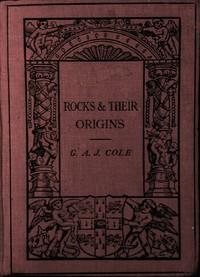|
|
Read this ebook for free! No credit card needed, absolutely nothing to pay.Words: 49453 in 20 pages
This is an ebook sharing website. You can read the uploaded ebooks for free here. No credit cards needed, nothing to pay. If you want to own a digital copy of the ebook, or want to read offline with your favorite ebook-reader, then you can choose to buy and download the ebook.

: Rocks and Their Origins by Cole Grenville A J Grenville Arthur James - Rocks@FreeBooksThu 08 Jun, 2023 CHAP. PAGE List of the common Minerals that form Rocks 8 References 162 Table of Stratigraphical Systems 189 Index 170 FIG. PAGE ON ROCKS IN GENERAL The description of rocks has fallen very much into the hands of lovers of analysis and classification, and attention has been diverted, even among geologists, from their fundamental importance as parts of the earth's crust. The geographer or the general traveller may often wish for closer acquaintance with the units that build up the scenery around him. The characters of rocks again and again control the features of the landscape. When studied more nearly, these same characters imply conditions of deposition or solidification, and lead the mind back to still older landscapes, and to the meeting of oceans and continents on long-forgotten shores. Petrology, indeed, involves the understanding of how rocks "come to be where we find them when we try"; but the classification of hand-specimens was from the first easier than field-investigation, and in later times the science was threatened with the description of isolated microscopic slides. Fortunately, a certain amount of feeling for natural history has been imported again into the subject, and evolutionary principles and sequences have been discussed. Experimental work, moreover, has been brought to bear on the question of the origins of rocks, with more success than might have been expected, since it is very difficult to realise in a laboratory, or even in the mind, the conditions that prevail in the lower parts of the earth's crust. Rocks, we have to remember, are in themselves considerable masses, and have relations with others far away. The coarseness of a sandstone at one point, or even over square miles of country, implies the deposition of finer material somewhere else. The lava-flow implies the existence of mysterious cauldrons in the crust. It is, however, fortunate that the primary classification of rocks was promulgated without regard for theories of rock-origins. The work was done by men who were masters and pioneers in mineralogy. At a time when a powerful school regarded basalt as of sedimentary origin, and when granite was generally believed to be the most ancient component of the crust, rock-masses were taken in hand as aggregates of certain minerals, and were reduced to an orderly scheme for arrangement in the cabinets of the curious. Any system based on ideal relationships would have been fatal at that time to petrology as a science. Alexandre Brongniart, in 1813, thus saw objections to the classification of rocks that had been proposed by Werner. In his "Essai d'une classification min?ralogique des Roches m?lang?es," he showed the impossibility of determining the age of a rock in relation to others before assigning to it a name, and the absurdity of separating similar rocks on account of differences in their geological age. Brongniart was thus forced to rely, firstly, upon the prevalence of certain mineral constituents, and, secondly, on the structure of the mass. He developed this scheme in 1827, in his "Classification et caract?res min?ralogiques des Roches homog?nes et h?t?rog?nes"; but it is clear that, even in such a system, considerations of natural history and of origin will ultimately predominate. Brongniart was much influenced by Karl von Leonhard's "Charakteristik der Felsarten," published in 1823, and these two authors have been regarded as the founders of petrography. The difficulty of distinguishing between rocks laid down as true sediments on the earth's surface and those that have consolidated from a state of fusion has been very largely removed. The assistance of the microscope can now be called on to elucidate the minute structure of fine-grained masses, which appeared homogeneous to earlier workers. The pioneer in microscopic methods was Pierre Louis Antoine Cordier, who knew rocks as a traveller knows them in the field. In 1798, as a young man of twenty-one, he had gone to Egypt with the famous expedition under General Bonaparte. D?odat de Dolomieu had charge of the geological observations, and Cordier went through the hardships of the campaign as his assistant. When Bonaparte abandoned the army and withdrew to Paris, Cordier might well have been lost to Europe. Free books android app tbrJar TBR JAR Read Free books online gutenberg More posts by @FreeBooks
: A Marriage in High Life Volume I by Scott Lady Caroline Lucy Bury Charlotte Campbell Lady Editor - Great Britain Social life and customs 19th century Fiction; Marriage Fiction@FreeBooksThu 08 Jun, 2023

: Hints to Travellers Scientific and General Vol. 2 Tenth edition revised and corrected by Royal Geographical Society Great Britain Reeves Edward Ayearst Editor - Topographical surveying; Scientific expeditions Handbooks manuals etc.; Spherical astronomy@FreeBooksThu 08 Jun, 2023
|
Terms of Use Stock Market News! © gutenberg.org.in2025 All Rights reserved.






